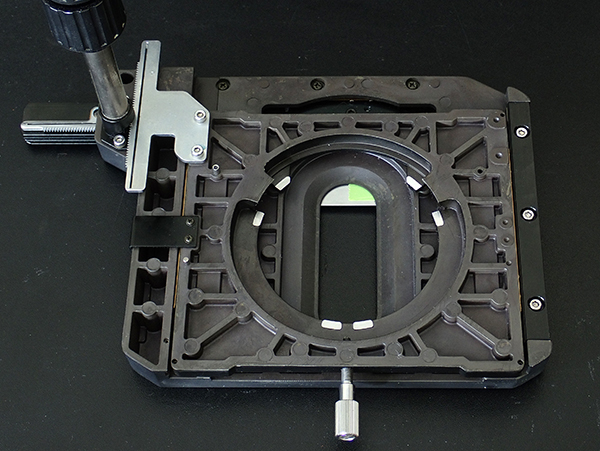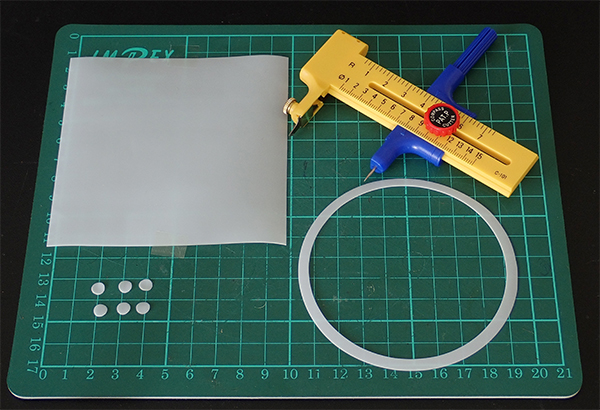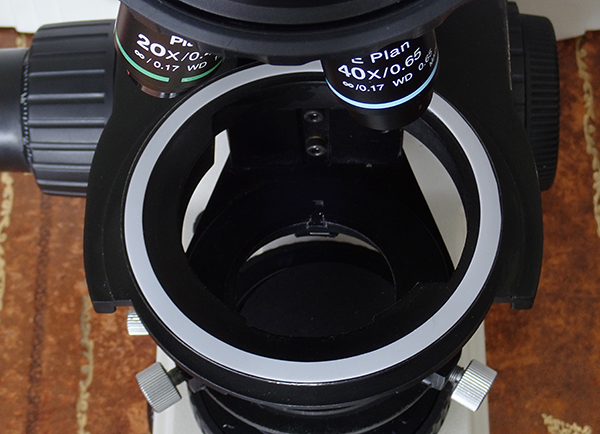
Micscape Topical Tip: Improving the action of some basic rotating stages.
Using the Nikon Eclipse 600 model as an example.
by David Walker, UK
An invaluable and for some techniques a vital feature of a microscope is a rotating stage, ideally centerable and on a good bearing. I seem to have appreciated this as a youngster many decades ago when I could afford my first microscope as I opted for one of the rotating stage 'R' models in the LOMO Biolam range which did not add a lot to the price at the time. I still have and
use this microscope. My main compound microscope now is a Zeiss Photomicroscope III which has the optional centering rotating circular stage with built in mechanical stage. Unfortunately it is often not a standard feature of many modern microscopes even those some way up a maker's model range. The polarising and arguably DIC versions always should have this feature but these variants of a model can often be considerably more expensive than the standard model.
Some recent 'biological' stands do have a form of rotating stage, where the rectangular stage has a release clamp to allow rotation to a lesser or greater extent. An excellent implementation is on the Nikon Eclipse 800 which rotates on a bearing race and is centerable. When set correctly even with a 100X objective a subject can rotate on its axis within the narrow field of view. This can be important for high mag studies where subject orientation is important such as off-axis oblique for 'diatom dotting' or for DIC.
The Nikon Eclipse 600, the model one below the 800, has a more basic rotating stage. The stage rotates on a metal dovetail in a non-centering mount, the mating surfaces are not finished to a high standard and run dry. This gives a lumpy action especially noticeable at higher powers with an unpleasant graunchy feel (and sound!). This is described as a 'mid-tier' microscope so it is a pity that Nikon did not spend a little more on a better bearing given that it can be used for techniques such as high mag DIC.

The stage rotates on the roughly finished six metal pads sitting on a bare metal ring on the stand. The action is lumpy and not ideal for use particularly at higher mags.
Ideally plastic pads should sit on these which did work for acetate sheet first tried. PTFE discs did not glue as too smooth.
To try and improve the action I cut a ring 83 - 93 mm from acetate sheet 0.2 mm thick to sit on the dovetail mount base and lightly oiled with Nye silicone oil and on the metal surfaces. Reinstalling this gave a noticeably smoother feel albeit somewhat stiffer than a ball bearing race. To see if it could be further improved I bought 0.25 and 0.5 mm thick 100 mm square PTFE sheets off eBay UK for a few pounds. These rings can be accurately cut with compass cutters, an item my brother Ian and I would never be without as so useful.

PTFE 0.25 mm sheet was easy to cut with a fresh blade in the compass cutter. An 83 - 93 mm diameter ring suited the Eclipse 600. Taping the sheet down while cutting is recommended.
PTFE sheet 0.5 mm was also bought but this seemed too thick, the 0.25 mm was thick enough not to distort under the stage load.
The PTFE discs were punched out to stick on the six metal pads so that PTFE acted on PTFE, but did not hold so the metal pads act on the PTFE ring.

The PTFE ring on the stage ring support. It was immobilised with some light solvent based UHU adhesive, Superglue does not act well on PTFE.
The ring was lightly oiled with Nye silicone oil as the metals pads are acting directly on it. Although still exploring plastic discs on the pads.
The acetate sheet first tried was a comparable action to the PTFE sheet later tried, possibly because plastic was acting on plastic for the acetate sheet so acetate may well suffice. The simple modification is certainly far superior in use than Nikon's design! Although not a centerable design, a subject does stay in the field with a 100x objective so the rotating stage is of value to the highest mags.
Comments to the author are welcomed.
Published in the October 2019 edition of Micscape.
Please report any Web problems or offer general comments to the Micscape Editor .
Micscape is the on-line monthly magazine of the Microscopy UK web site at Microscopy-UK
©
Onview.net Ltd, Microscopy-UK, and all contributors 1995
onwards. All rights reserved.
Main site is at
www.microscopy-uk.org.uk.